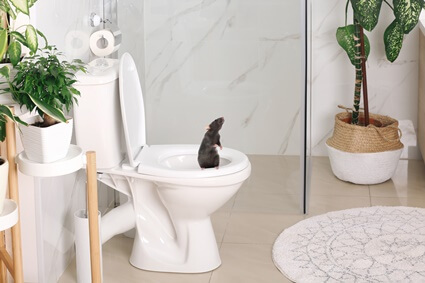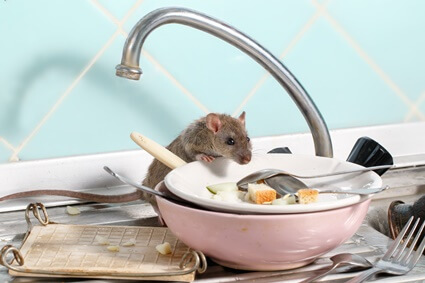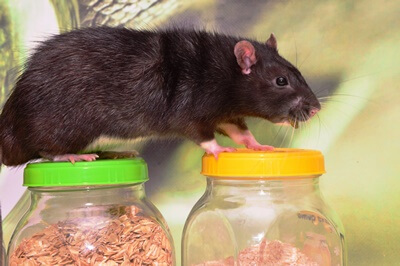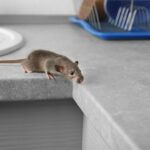Rats are nocturnal creatures, so they’re rarely seen. This makes it difficult to know where they’re nesting or spending their time. However, there are places where rats like to hide.
Rats prefer to nest in places that humans and other predators don’t or rarely enter.
Aside from offering safety and security, rats also seek food, water, and warmth. Rats’ most common hiding spots include attics, walls, garages, basements, roofs, drains, sewers, and pipework.
Once inside the home, rats find a secure, isolated place to hide during the day, rarely emerging. They’ll usually only emerge at night to forage for food, water, and other resources.
How Do You Find A Hidden Rat In Your House?
These warning signs will indicate where rats are hiding:
Strange Sounds and Smells
Rats are stealthy movers. However, they may reveal themselves with loud squeaking, screaming, scratching, and rustling. They make noises as they move around and jostle among themselves.
They also leave a strong ammonia scent in areas they regularly frequent due to their urine.
Rat Droppings
Rats leave poop as they move around your home.
If you find sausage-shaped droppings littered around the home, this is a sign of rodent activity. New waste tends to have a glossy appearance, while old waste is more dull and crumbly.
You need to be able to distinguish between mouse and rat poop.
Nesting Material
Rats require a warm, safe place to shelter and reproduce.
That’s why they set up nests in isolated areas of your home. If you come across bits of shredded paper, fabric, and other materials in corners and behind objects, this is likely where rats are hiding.

Where Do Rats Hide In Bathrooms?
Bathrooms are a favorite location for rats to hide. The water supply provides a dependable source of hydration for rats to drink and cool themselves when hot.
Additionally, bathrooms don’t experience as much human activity as other areas, so rats can hide there for long periods without being confronted.
Hiding places in bathrooms include:
- Behind bathtubs.
- Inside cabinets.
- Behind toilet drain pipes.
- Inside bathroom trash bins.
- Between heaps of towels and clothing.
Sometimes, rats emerge from toilets if there isn’t a cut-off valve.
Where Do Rats Hide In Bedrooms?
Bedrooms offer warmth, protection from predators, and often food. If you eat snacks at night or in bed, crumbs can sustain a rat until it finds a more plentiful food source.
Bedrooms are often kept temperature-regulated at night and left empty during the day, providing rats comfort, safety, and privacy.
If you want to find rats in the bedroom, check the following places:
- Inside closets.
- Under beds.
- In piles of clothes.
- Behind bedside drawers.
- Under bedside tables and nightstands.
- Behind trash bins.
Where Do Rats Hide In The Kitchen?
The kitchen is the favorite place for rats to hide inside a home.
Rats are initially attracted by the smell of food, including the scent of disposed or rotting food inside garbage bins.
By establishing nests close to the kitchen, rats are guaranteed a steady supply of meals to nourish themselves without venturing too far.
The most common places rats hide in a kitchen include:
- Behind microwaves.
- Underneath or behind fridges.
- Inside food storage pantries.
- Behind or inside dishwashers.
- Inside utensil racks.
- Behind ovens.
- Inside floor-level kitchen cabinets.
Do Rats Hide In Walls?
Rats usually enter homes through small holes and cracks in walls. According to the University of California, rats can squeeze through any opening greater than ½ inch.
Rats use holes as entry points and build nests inside walls. So, if you’ve been hearing strange noises behind your walls at night, the chances are that you have rats.
Rats love to hide behind walls for temperature and privacy reasons. After all, electrical appliances such as air conditioner vents and home heating systems provide warmth and comfort.
Rats can live inside a wall for weeks or months without disruption, reproducing frequently. They can also damage the wall structure and electrical cables.
If rats die inside walls, they’ll produce a foul smell.
Do Rats Like to Hide On The Roof?
Wild rats, particularly roof rats, favor a home’s attic and roofing structure.
These rats nest on elevated surfaces. If you suddenly hear scratching noises or the pattering of feet inside your roof eaves, you may have one or more rats living there.
Can Rats Hide In Plumbing Pipes?
Species like Norwegian rats hide in underground locations, such as sewers and drain pipes. These areas provide feeding opportunities and a secure place to hide from predators like cats, ferrets, and dogs.
According to Frontiers in Physiology, rats are prolific swimmers, capable of altering their swimming force and paddling rate. This feat allows them to conserve energy and prevent drowning in sewers.
Moreover, rats can swim up to half a mile and wade through water for up to 3 days. This makes it possible for rats to survive inside sewers and plumbing pipes, even with high water currents.

How To Lure A Rat Out of Hiding
Rats will be extra cautious when there’s a human threat lurking nearby.
Furthermore, rats are skilled runners, making catching them in the open difficult. Despite that, it’s possible to outsmart a rat and get it out of its hiding place.
Here are tips for luring rats out:
Food Bait
To lure a rat out of hiding, entice it with delicious food bait.
The best foods for drawing out a rat include:
- Bacon.
- Chocolate.
- Peanut butter.
- Dried fruits.
Leave The Area
Rats are scared of humans and will avoid confrontation. So, if a rat knows that you’re lurking in the area, it’ll stay in its hideout.
To draw a rat out of hiding, exit the area once you have set up the bait. This signals to the rat that there’s no threat, encouraging it to come out of hiding to explore and gather resources.
Chemical Rat Attractant
Commercial rat attractants are chemical compounds that mimic the scent of rat saliva.
Putting attractants near a rat hole or hideout will make the rat curious and lure it out of hiding. You can purchase chemical rat attractants from the pest control aisles at supermarkets.
Rats hide out of sight in small, quiet areas. If you’re searching for rats in your home, check dark places that see little activity and provide a warm resting area.
Behind appliances, under furniture, and even inside your walls are prime hiding spots for a rat.







